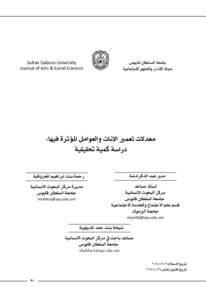Document
معدلات تعمير الإناث والعوامل المؤثرة فيها: دراسة كمية تحليلية.
Contributors
المحروقية, رحمة بنت إبراهيم., Author
المديلوية, شيخة بنت حمد., Author
Publisher
جامعة السلطان قابوس. كلية الآداب والعلوم الاجتماعية
Gregorian
2017
Language
Arabic
English abstract
The study aimed to detect the expectations of life expectancy of women since birth according to the diversity of the communities and to examine the most important social, cultural, economic, and demographic determinants. These have been identified as: the proportion of annual population increase, rates of infant mortality, the rate of the crude death, the rate of population density per cubic meter, the population of the state, the period during which the population doubles, the total fertility rate, the rate of birth control use, the level of individual income, the proportion of youth in the community (population less than 15 years), and the rate of urbanization. The study relied on the annual global data for 242 countries provided by the United Nations for all countries in the world which is known as the World Population Data Sheet.
The study found that females live longer than males, and variables such as infant mortality, the proportion of youth in a community, the rate of crude mortality, total fertility of women and rate, and the relative use of birth control methods in the community, all play an influential role in determining the levels of the woman's life expectancy.
Member of
ISSN
2312-1270
Resource URL
Citation
كرادشة، منير عبد الله والمحروقية، رحمة بنت إبراهيم والمديلوية، شيخة بنت حمد (2017). معدلات تعمير الإناث والعوامل المؤثرة فيها: دراسة كمية تحليلية. مجلة كلية الآداب والعلوم الاجتماعية، 8 (2)، 91-107.
Arabic abstract
هدفت الدراسة إلى الكشف عن توقعات عمر المرأة المأمول أو المتوقع أن تعيشه منذ الولادة حسب تنوع المجتمعات، ومعاينة أهم محدداته الاجتماعية والثقافية والاقتصادية والديموغرافية، والتي تم حصرها في الآتي: "نسبة الزيادة السكانية السنوية، ومعدلات وفيات الأطفال الرضع، ومعدل الوفاة الخام، ومعدل كثافة السكان في المتر المربع الواحد، وعدد سكان الدولة، والمدة التي يتضاعف فيها عدد السكان، ومعدل الخصوبة الكلية، ونسبة وسائل تنظيم الأسرة، ومستوى دخل الفرد السنوي، ونسبة فتوة المجتمع (عدد السكان أقل من 15 سنة)، ونسبة التحضر". واعتمدت الدراسة على البيانات العالمية السنوية ل (242) دولة، والمقدمة من قبل هيئة الأمم المتحدة لكافة دول العالم والمعروفة ب (World Population Data Sheet).
وقد توصلت الدراسة إلى أن الإناث أطول عمرا من الذكور، وأن متغيرات مثل: "وفيات الأطفال الرضع، ونسبة فتوة المجتمع، ومعدل الوفاة الخام، ومعدل الخصوبة الكلية للمرأة، ونسبية استخدام وسائل تنظيم الأسرة في المجتمع"، تؤدي جميعها دورا مؤثرا في تحديد مستويات عمر المرأة المتوقع أو المأمول منذ الولادة.
وقد توصلت الدراسة إلى أن الإناث أطول عمرا من الذكور، وأن متغيرات مثل: "وفيات الأطفال الرضع، ونسبة فتوة المجتمع، ومعدل الوفاة الخام، ومعدل الخصوبة الكلية للمرأة، ونسبية استخدام وسائل تنظيم الأسرة في المجتمع"، تؤدي جميعها دورا مؤثرا في تحديد مستويات عمر المرأة المتوقع أو المأمول منذ الولادة.
Category
Journal articles



